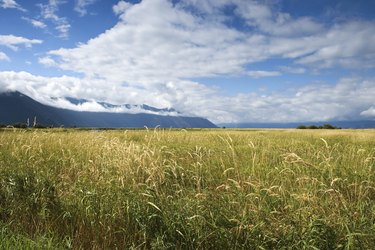
Grass plants are adaptable, growing in nearly any type of soil and adverse condition. These plants are available in a variety of color and height from short bonsai grass, which is only a couple of inches tall, to tree-sized bamboo, which is the tallest of the grass plants. The tassels on the top of a grass stem are actually the flowers of these plants. Nearly all grass species will produce tassels as a form of reproduction unless the grass is kept mowed.
Anatomy
Video of the Day
Grass plants produce rhizomes, which are root-like structures that grow new grass plants when near the surface. The places where the grass stems begin on the plant are called nodes. Blades of grass continuously grow from the nodes and are replaced when the grass is cut. Without this feature, grass would become extinct because of mowing and grazing animals. A group of flowers on a grass plant is call inflorescence or tassels. A single grass flower is referred to as a spikelet.
Video of the Day
Function
Tassels are produced only on seed-bearing stems. These stems are not like the regular blades of grass because when these stems are cut, they do not grow back. The tassels play an important role in the reproduction of grass by assisting the spread of the seeds. The dry seeds are release and scattered in the wind. The higher the tassel, the farther the seeds spread.
Types
There are three main types of tassels produced by grass. Panicles are branches of stems hanging off the center stalk with spikelets at the end of each branch. Oat grass, sudagrass, Kentucky bluegrass and tall fescue all produce panicles. Racemes are uncommon with small stems off the central stalk that does not branch. Racemes are found on foxtail millet, smooth crabgrass and dallisgrass. Spikes are central stalks with spikelets attached directly onto the stems. This form appears in wheat, barley, ryegrass and wheatgrass.
Ornamental
Ornamental grasses are usually tall, large plants and give a vertical element to the landscape. In ornamental grass, the tassels are valued for their texture and colors, which include silver, gold and pink. These varieties of grasses provide graceful movement and color to a winter garden. The tassels of ornamental grass are commonly dried and used in dried flower arrangements. The plumes are cut when the flowers are dried and then sprayed with a preservative to prevent the seeds from scattering.